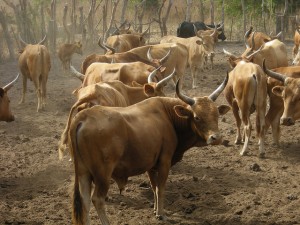
N’Dama is a hardy breed of cattle indigenous to the Fouta-Djallon highlands in the West African country of Guinea. N’Dama cows were domesticated around 8,000 years ago in the region and they have evolved to be resistant to local diseases and parasites. The breed is common throughout West and Central Africa, especially in areas infested by the tsetse fly—an insect known to transmit disease to both humans and livestock. According to the FAO, there are approximately 7 million head of N’Dama cattle.
N’Dama cows produce two to three liters of milk per day and their meat is renowned for its flavor. The breed is the most popular among West Africa’s small-scale, low-input livestock keepers. This is largely because they are heat tolerant, are docile and do well in harsh environments, and can survive on poor quality feeds.
But the most important quality of N’Dama is its resistance to trypanosomiasis, a widespread African cattle disease spread by the tsetse fly. In the areas of Africa with the greatest potential to increase domestic livestock production, trypanosomiasis is a major constraint. Because of its natural resistance to the disease, N’Dama cows do not require expensive antibiotics to be healthy. For this reason, N’Dama is seen as the breed of choice to help West and Central Africa meet the increasing demand for meat and milk products.
The International Trypanotolerance Centre (ITC) has launched an N’Dama improvement program in The Gambia. The program uses 400 breeding cows to try and select larger, higher milk-producing animals that retain disease-resistant qualities. A company in the Democratic Republic of Congo called Jules VAN LANCKER, in collaboration with the International Livestock Research Institute (ILRI), has used its herd of over 40,000 purebred N’Dama to breed desirable qualities without losing hardiness. According to ILRI, the company has increased the average weight of its N’Dama cattle by 30 to 50 kilograms per animal through selective breeding.
Economically, livestock production is the fastest growing sector in agriculture worldwide. Livestock-keeping can be an important way to improve diets and raise incomes in the developing world. Less well-known livestock breeds contain valuable resources that could be vital for food security and help farmers deal with the challenges of climate change, animal disease, and dwindling water supplies.
Matt Styslinger is a research intern with the Nourishing the Planet project.

Danielle Nierenberg, an expert on livestock and sustainability, currently serves as Project Director of State of World 2011 for the Worldwatch Institute, a Washington, DC-based environmental think tank. Her knowledge of factory farming and its global spread and sustainable agriculture has been cited widely in the New York Times Magazine, the International Herald Tribune, the Washington Post, and
other publications.
Danielle worked for two years as a Peace Corps volunteer in the Dominican Republic. She is currently traveling across Africa looking at innovations that are working to alleviate hunger and poverty and blogging everyday at Worldwatch Institute’s Nourishing the Planet. She has a regular column with the Mail & Guardian, the Kansas City Star, and the Huffington Post and her writing was been featured in newspapers across Africa including the Cape Town Argus, the Zambia Daily Mail, Coast Week (Kenya), and other African publications. She holds an M.S. in agriculture, food, and environment from Tufts University and a B.A. in environmental policy from Monmouth College.








